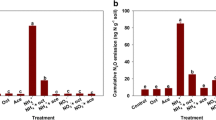Abstract
Acetylene-reducing activities (ARA) of strains ofEnterobacter agglomerans, Azospirillum brasilense, Azotobacter chroococcum, and Bacillus, isolated from temperate or tropical soils, were compared at different temperatures to study temperature adaptability. All Enterobacter strains and Bacillus strain C-11-25 reduced C2H2 at temperatures as low as 5°C. ARA by Enterobacter strains declined sharply above 30°C but ARA by Bacillus strain C-11-25 continued to increase with an increase in temperature.A. brasilense strain sp 245, isolated from wheat roots in Brazil, reduced more C2H2 at lower temperatures than strain Cd, isolated from a Californian soil. Similarly, the temperate strain ofA. chroococcum was a better N2 fixer than the tropicalA. chroococcum strain at lower temperatures. Tropical strains ofA. brasilense andA. chroococcum reduced more C2H2 than temperate strains at higher temperatures. Therefore, it appears that temperate and tropical N2-fixing organisms adapt themselves to their particular environment and should have more potential to benefit crops grown at the particular temperatures favorable to them.
Only Bacillus strain C-11-25 has potential to benefit both temperate and tropical crops because it reduced significant acetylene over a wide temperature range.
Similar content being viewed by others
References
Baldani V L D, Baldani J I, Döbereiner J 1983 Effects of Azospirillum inoculation on root infection and nitrogen incorporation in wheat. Can. J. Microbiol. 29, 924–929.
Becking J H 1961 Studies on nitrogen-fixing bacteria of the genus Beijerinckia. I. Geographical and ecological distribution in soils. Plant and Soil 14, 49–81.
Becking J H 1981 The family Azotobacteraceae.In The Procaryotes: A Handbook on Habitats, Isolation, and Identification of Bacteria. Eds. M P Starr, H Stolp, H G Trüper, A Balows, H G Schlegel. Vol. I. pp 795–817. Springer-Verlag, Berlin, Heidelberg.
Boddey R M and Döbereiner J 1982 Association of Azospirillum and other diazotrophs with tropical graminae. 12th International Congress on Soil Science Symposia Papers, 8–16 February 1982, New Delhi. Vol. 1, pp 28–47. International Society of Soil Science, FAO Rome.
Döbereiner J 1967 Nonsymbiotic nitrogen fixation in tropical soils.In Biology and Ecology of Nitrogen. Proceedings of a Conference, University of California, Davis 28 November-1 December 1967. pp 114–128 National Academy of Science, Washington, DC.
Döbereiner J 1980 Forage grasses and grain crops.In Methods for Evaluating Biological Nitrogen Fixation. ed. F J Bergersen. pp 535–555. John Wiley & Sons, New York.
Greene R A 1932 The effect of temperature upon the nitrogen fixation by Azotobacter. Soil Sci. 33, 153–161.
Hardy R W F, Holsten R D, Jackson E K and Burns R C 1968 The acetylene-reduction assay for N2-fixation: laboratory and field evaluation. Plant Physiol. 43, 1185–1207.
Jain D K and Patriquin D G 1984 Root hair deformation, bacterial attachment, and plant growth in wheat—Azospirillum associations. Appl. Environ. Microbiol. 48, 1208–1213.
Kapulnik Y, Sarig S, Nur I, Okon Y, Kigel K and Henis Y 1981 Yield increases in summer cereal crops in Israeli fields inoculated with Azospirillum. Exper. Agric. 17, 179–187.
Kleeberger A, Castorph H and Klingmüller W 1983 The rhizosphere microflora of wheat and barley with special reference to gram-negative bacteria. Arch. Microbiol. 136, 306–311.
Klingmüller W, Shanmugam K T and Singh M 1983 Nifhybrids of enterobacter: Selection fornif gene integration with chlorate. Mol. Gen. Genet. 191, 221–224.
Larson R I and Neal J L 1978 Selective colonization of the rhizosphere of wheat by nitrogen-fixing bacteria. Ecol. Bull. (Stockholm) 26, 331–342.
Neal J L and Larson R I 1976 Acetylene reduction by bacteria isolated from the rhizosphere of wheat. Soil Biol. Biochem. 8, 151–155.
Neyra C A and Döbereiner J 1977 Nitrogen fixation in grasses. Adv. Agron. 29, 1–38.
Rennie R J, DeFreitas J R, Ruschel A P and Vose P B 198315N isotope dilution to quantify dinitrogen (N2) fixation associated with Canadian and Brazilian wheat. Can. J. Bot. 61, 1667–1671.
Rennie R J and Larson R I 1979 Dinitrogen fixation associated with disomic chromosome substitution lines of spring wheat. Can. J. Bot. 57, 2771–2775.
Steel R G D and Torrie J M 1960 Principles and Procedures of Statistics. McGraw-Hill, New York.
Subba Rao N S 1981 Response of crops toAzospirillum inoculation in India.In Associative N2 Fixation. eds. P B Vose and A P Ruschel, pp 137–143. CRC Press, Boca Raton, FL.
Author information
Authors and Affiliations
Rights and permissions
About this article
Cite this article
Jain, D.K., Beyer, D. & Rennie, R.J. Dinitrogen fixation (C2H2 reduction) by bacterial strains at various temperatures. Plant Soil 103, 233–237 (1987). https://doi.org/10.1007/BF02370394
Received:
Revised:
Issue Date:
DOI: https://doi.org/10.1007/BF02370394




